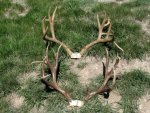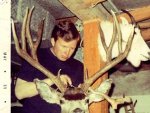I've had a little trouble getting my first new thread posted properly. Had to have the administrator delete a couple of my first tries. I'm a new participant in this forum but actually I've been a member for a year and a half. I thought this posting would be a good way to introduce myself and show that mule deer are one of my main passions. I've hunted a lot of years but I'm still looking for that monster mule deer and having a lot of fun trying. Hopefully, this post will help some of you to really rev up for next years mule deer season!
Beginning of April, a great time to be out fishing here in Montana. I’ve been doing some of that. But, like most of you, I’ve also been busy applying for hunting tags both here in Montana and a few other states as well. Maybe it has been the application process that has gotten my mind on mule deer. Montana is not well known for really big mule deer bucks. Because of that notion I’ve been preoccupied for a number of years now with the need to hunt places like Colorado, Wyoming’s Greys River country, Alberta and most recently Nevada. These places are great for big trophy bucks and I will continue applying for tags in all of them. However, Montana has and I believe still can produce some high quality mule deer bucks despite the fact that there are many more hunters out there, access is tougher, droughts are hard on them, and we have been hunting them hard right thru the rut.
I just recently realized that I know of five bucks that are world class in most people’s book which were taken between the 1960’s and early 2000’s within a radius of 25-miles from where I live near Helena Montana. Four of the five were taken on public land DIY style. The fifth one which I picked up in 1966 was taken by an unknown hunter. I am assuming it was taken near the place where I found it which is a combination of public and private land. But land where anyone could hunt, especially in those days.
I’ll start with the buck I found in 1966. In those days and the years between the late 1940’s and the mid 60’s horns and antlers were not held in such high esteem or valued by hunters the way we value them today. Consequently, it was not uncommon to hear about someone taking a 6-point bull elk and loping its head off to bring home only the meat and maybe the teeth. Likewise, big bucks were killed for meat and their heads were left in the field. Another thing hunters did was bring out the head or antlers and show them off a little then simply throw them on to the pile of antlers out back. Where they weathered and got chewed on by rodents, etc. Wasted away!
During the fall of 1966 I was riding with my friend in his Willys jeep when we stumbled into an old abandoned falling down cabin with a 6-feet high stack of antlers in back. There were elk and deer antlers and sheds. They were all old and faded out white. I spotted the left horn of this buck way down in the stack. Dug him out just because we were interested in seeing just how big he was. He was huge. I kept him and made an effort to re-color the antlers. I still have him today. Took him off the wall and cleaned the antlers up to take these pictures. 35” total width – 213” gross score - 27” main beams.
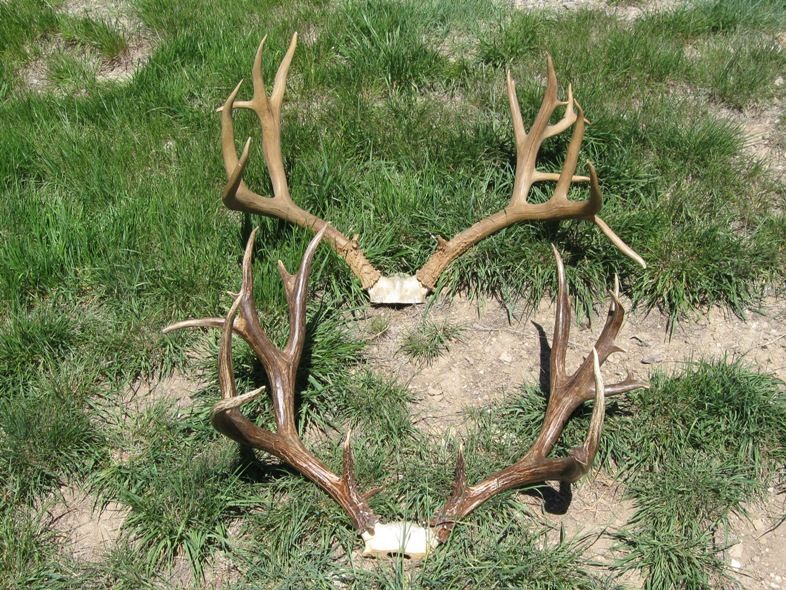
About that same time (1966) my good friend and hunting buddy was hunting in November after a snow storm with some of his relatives and came on this next buck with a bunch of does. He has a broken main beam on his left side and yet still manages to score 204 3/8” gross in 2012. His antlers have 10-points on the right and 9 on the left side. He is 34 1/8" wide and his right G-2 is 18 0/8”. We estimate that approximately 6” was broken off the main beam.
69-inches of combined spread!
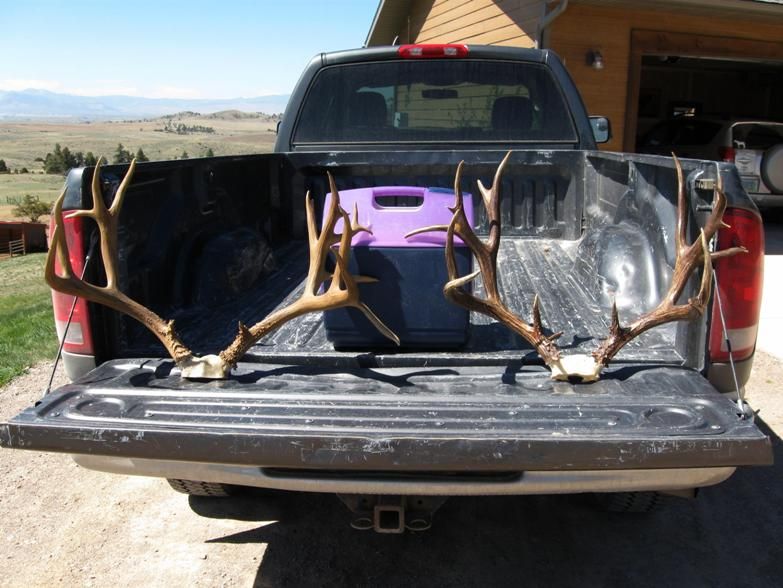
In 1968 when I was just starting out self teaching myself taxidermy a hunter from Helena brought in an unbelievably BIG mule deer for me to mount. This buck was so tall it didn’t look wide. The tape measure however, read 29 ½- inches wide! The basic typical score was an unbelievable 203 0/8” gross (green). With 23 5/8” of non-typical points including a 14” drop tine, he scored 226 5/8” gross non-typical (green).

In 1979 I took my young brother-in-law out to get his first deer. We were sitting eating our lunch when a huge buck walked out in front of us. He stopped quartering away and looking back at us right in the middle of a patch of snow. We had both grabbed our rifles. I didn’t even put my binoc’s on him when I said my famous quote, “If you aren’t going to shoot I will.” He shot. I caped the buck, cut off the skull cap and quartered him. We hauled out 206-pounds of buck after coming back up the mountain with our backpacks. This buck grossed 188” Typical with 6 or 8-inches of non-typical points to boot.
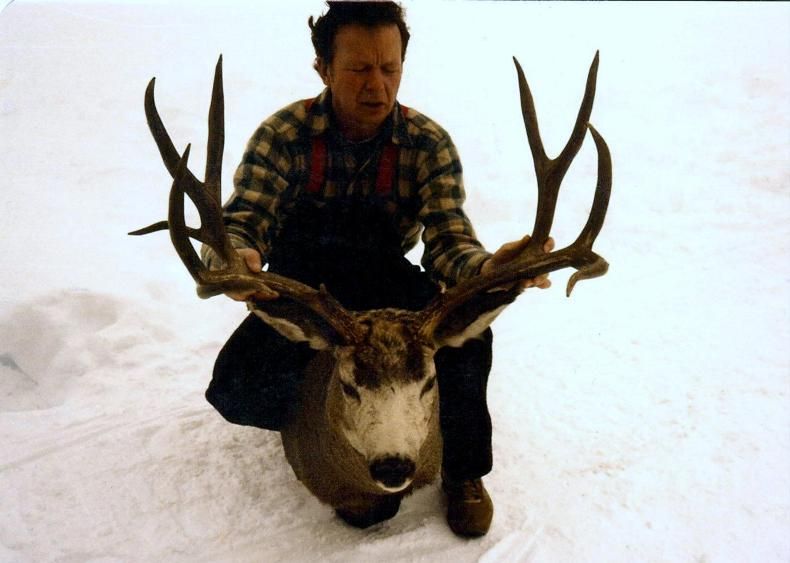
The fifth buck is very similar to the one with the broken main beam shown above and its from the same hunting unit. It scores over 200” gross non-typical and was taken by some friends in 2004.
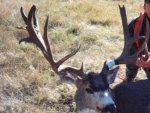
Beginning of April, a great time to be out fishing here in Montana. I’ve been doing some of that. But, like most of you, I’ve also been busy applying for hunting tags both here in Montana and a few other states as well. Maybe it has been the application process that has gotten my mind on mule deer. Montana is not well known for really big mule deer bucks. Because of that notion I’ve been preoccupied for a number of years now with the need to hunt places like Colorado, Wyoming’s Greys River country, Alberta and most recently Nevada. These places are great for big trophy bucks and I will continue applying for tags in all of them. However, Montana has and I believe still can produce some high quality mule deer bucks despite the fact that there are many more hunters out there, access is tougher, droughts are hard on them, and we have been hunting them hard right thru the rut.
I just recently realized that I know of five bucks that are world class in most people’s book which were taken between the 1960’s and early 2000’s within a radius of 25-miles from where I live near Helena Montana. Four of the five were taken on public land DIY style. The fifth one which I picked up in 1966 was taken by an unknown hunter. I am assuming it was taken near the place where I found it which is a combination of public and private land. But land where anyone could hunt, especially in those days.
I’ll start with the buck I found in 1966. In those days and the years between the late 1940’s and the mid 60’s horns and antlers were not held in such high esteem or valued by hunters the way we value them today. Consequently, it was not uncommon to hear about someone taking a 6-point bull elk and loping its head off to bring home only the meat and maybe the teeth. Likewise, big bucks were killed for meat and their heads were left in the field. Another thing hunters did was bring out the head or antlers and show them off a little then simply throw them on to the pile of antlers out back. Where they weathered and got chewed on by rodents, etc. Wasted away!
During the fall of 1966 I was riding with my friend in his Willys jeep when we stumbled into an old abandoned falling down cabin with a 6-feet high stack of antlers in back. There were elk and deer antlers and sheds. They were all old and faded out white. I spotted the left horn of this buck way down in the stack. Dug him out just because we were interested in seeing just how big he was. He was huge. I kept him and made an effort to re-color the antlers. I still have him today. Took him off the wall and cleaned the antlers up to take these pictures. 35” total width – 213” gross score - 27” main beams.

About that same time (1966) my good friend and hunting buddy was hunting in November after a snow storm with some of his relatives and came on this next buck with a bunch of does. He has a broken main beam on his left side and yet still manages to score 204 3/8” gross in 2012. His antlers have 10-points on the right and 9 on the left side. He is 34 1/8" wide and his right G-2 is 18 0/8”. We estimate that approximately 6” was broken off the main beam.
69-inches of combined spread!

In 1968 when I was just starting out self teaching myself taxidermy a hunter from Helena brought in an unbelievably BIG mule deer for me to mount. This buck was so tall it didn’t look wide. The tape measure however, read 29 ½- inches wide! The basic typical score was an unbelievable 203 0/8” gross (green). With 23 5/8” of non-typical points including a 14” drop tine, he scored 226 5/8” gross non-typical (green).

In 1979 I took my young brother-in-law out to get his first deer. We were sitting eating our lunch when a huge buck walked out in front of us. He stopped quartering away and looking back at us right in the middle of a patch of snow. We had both grabbed our rifles. I didn’t even put my binoc’s on him when I said my famous quote, “If you aren’t going to shoot I will.” He shot. I caped the buck, cut off the skull cap and quartered him. We hauled out 206-pounds of buck after coming back up the mountain with our backpacks. This buck grossed 188” Typical with 6 or 8-inches of non-typical points to boot.

The fifth buck is very similar to the one with the broken main beam shown above and its from the same hunting unit. It scores over 200” gross non-typical and was taken by some friends in 2004.

Attachments
-
67.9 KB Views: 56
-
24.5 KB Views: 52
-
83.1 KB Views: 56
-
15.1 KB Views: 55
Last edited:


